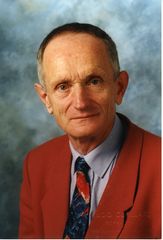17th June 2020, videoconference: PhD defense of Steffen Wittrock
Steffen Wittrock will defend his thesis the 17th of June 2020 at 2 PM on: “From noise and stability to synchronization and complex dynamics in spin torque nano-oscillators”, prepared at Unité Mixte de Physique CNRS/Thales under the supervision of Vincent Cros.
The defense will take place by videoconference on the following link: https://eu.bbcollab.com/guest/b31b21c721ae4c33b9884ff429ef40a8
Death of Raymond Besson, “the man of the quartz at 10-14“

Passionate scientist, professor at ENSMM (Besançon, France) until 2006 and director of the Chronometry, Electronics and Piezoelectricity Laboratory of Besançon between 1978 and 2002, Raymond Besson was renowned in the national and international time-frequency community for his so-called BVA quartz resonators. He died on April 15, 2020.
Two-Way Satellite Time and Frequency Transfer: first use of a Software Defined Radio receiver in UTC calculation
Two-Way Satellite Time and Frequency Transfer, improved by the Software-Defined Radio (SDR) receiver, has been used for Circular T calculation for the first time in March 2020. The comparison between the French and German local realizations of UTC, UTC(OP) and UTC(PTB), was performed using SDR receivers, a method that replaces part of the time-transfer hardware with high-speed digitization and software data processing. This significantly improves the 1-day stability of the time comparison.
How did the ancient Greeks conceive of time?
Interdisciplinary traveling exhibition on the theme of time (in french)
FIRST-TF Calls for projects 2020 are opened ; deadline April 10th 2020 [Update COVID19]
The FIRST-TF calls for projects 2020 are now opened. The deadline is April 3rd 2020 April 10th 2020 [Update COVID 19].
IMPORTANT: this year, we introduce 2 parralel calls. The usual “one-year project” call, and in addition, a new “multi-year project” call. There is two distincts forms for these two calls.
The texts of the calls and the forms to fill-in can be downloaded here :
[note COVID 19: in case of difficulties in transmitting the “signature pages”, an email to contact@first-tf.fr from the direction of the structure involved will also be accepted]
“One-year project” call 2020 ; “One-year project” form 2020
“Multi-year projects” call 2020 ; “Multi-years projects” form 2020
REFIMEVE+ General Assembly, 1-2 April 2020 in Grenoble (France) [UPDATE COVID19: event Postponed]
The REFIMEVE+ project (fiber network of frequency reference distribution at ultra-high performance ) will take placeat the LIPhy laboratory (Grenoble) the 1st et 2nd of Avril 2020 [COVID19 : the event is postponed].
This general assembly is opened to REFIMEVE partners and every people interested in joining the project.
An on-line registration form and a preliminary program will be distributed soon.
Important subjects that will be discussed are : progress of the network, realization and performance of the Paris-Grenoble link, connexion between the Refimeve+ network and Italy, on-going applications.
International Timing & Synchronisation Forum 2020
ITSF covers applications including Telecoms, Finance, Energy, Transport, Broadcast, Data Centers and Defence.
November 2-5, Dusseldorf (Germany)
Abstract submission deadline for IFCS 2020: February 17
Joint conference of the IEEE Frequency Control Symposium & IEEE International Symposium on Applications of Ferroelectrics.
July 19-23, 2020, Keystone (Co, USA).
Registration for EFTF 2020 is now open
The “European Frequency and Time Forum” (EFTF) conference will take place in Noorwijk (Netherlands) 20-23 April 2020. Registratio is now open, and the “early birds” fee available untilFebruary 13th.
==> information
22nd to 28th of August 2020 : NCSLI/CPEM 2020 (Denver, CO, USA)
The NCSLI/CPEM 2020 Workshop & Symposium will be hosted in Denver, Colorado, at the Gaylord Rockies Resort & Convention Center. This year Conference on Precision Electromagnetic Measurements (CPEM) will be hosted concurrently with the NCSLI Annual Conference. The 2020 conference theme is “The SI Unleashed — Bridging Science & Metrology”.
==> informations
